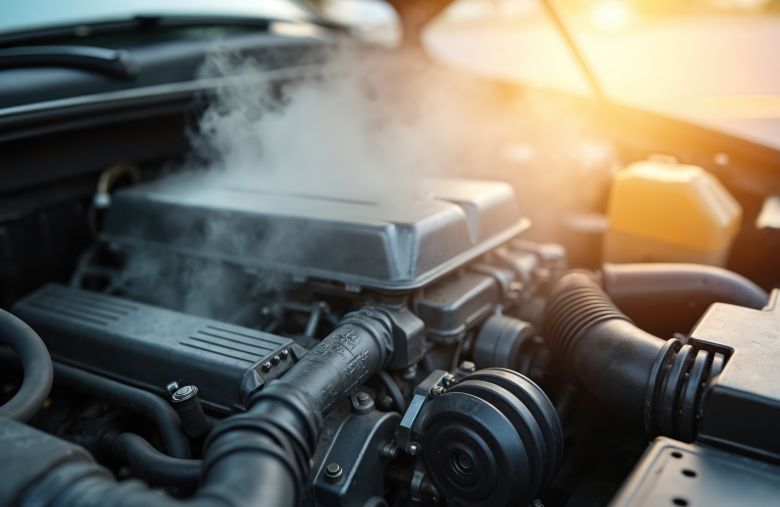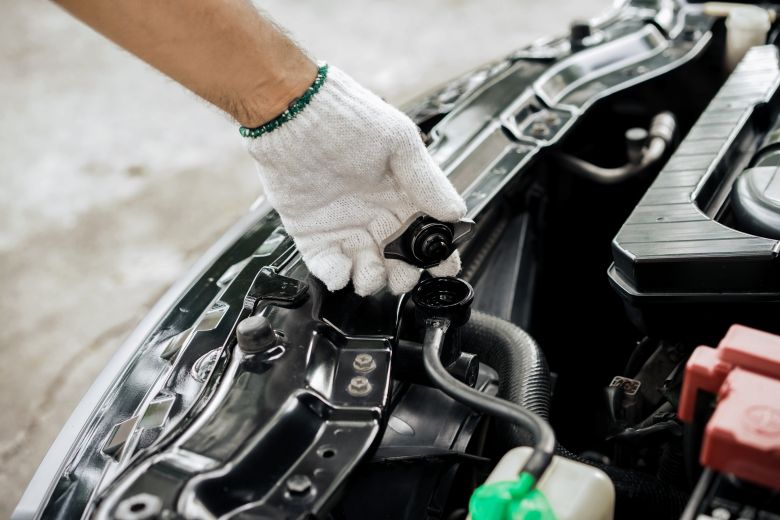
5 Signs It's Time to Change Your Coolant
- Vehicle Maintenance
- PEAK
- October 15, 2025
Learn the car clues that can save you from a breakdown or a pricey repair bill.
With the late summer heat roasting cars all over the country, it's the perfect time to talk about coolant. If you're like most drivers, you probably don't think much about this vital fluid if it's doing its job. However, coolant has a limited lifespan and you don't want to wait until you're late for work and your engine is overheating to realize it's time to act.
There's good news on that front: Your car will give you clues that you need a coolant change. Some are obvious, but others aren't so clear. Knowing what to look for can potentially save you from an inconvenient breakdown and a sky-high repair bill.
Look for these five warning signs that it’s time to change your coolant:
- Your cooling system isn't working right
- Your coolant is discolored
- Your car gives off a sweet or burned odor
- You hear hissing or gurgling when you start your car
- It's been too long since your last coolant change
Let's dive deeper into each of these warning signs, with added insights from PEAK's in-house coolant expert, product marketing manager Michael Marcangelo.

Sign #1: Your cooling system isn't working right
Your car has many ways of telling you that something's wrong with your cooling system or coolant. Take action if you notice any of these symptoms:
Your engine runs hot — especially more than once
It doesn't take long for an overheating engine to cause serious damage. If your temperature gauge hits the red zone, or if you see steam coming from your engine, get off the road as soon as you can.
You'll need repairs if things reach this level, but you might be tempted to overlook a temperature gauge that creeps high but doesn't quite go red. Don't make that mistake, especially if it happens repeatedly. You could suffer serious engine damage.
You have a visible engine coolant leak
If you notice weird puddles on your driveway or under your parked car, you might have a leak in your cooling system. Michael explains exactly what to look for:
"[Coolant] has a consistency similar to water, but it will have a color specific to your type of vehicle," he says. "If you see a watery colored puddle under your engine, that might indicate a leak within the cooling system."
In the event of a coolant leak, you can either take your car in for service or try to diagnose the cause yourself. As a first step, see if you can pinpoint the leak's exact location. It could be in your hoses, pump, or radiator. Check these components for corrosion, cracks, or faulty connections.
Depending on what you find, you might try to seal minor cracks or gaps, or tighten loose connections. If these fixes don't help, or if you find a bigger issue, have a pro take a look.
Coolant levels are constantly low
In our posts on DIY spring car maintenance and tips for maintaining your first new car, we explain the importance of regular coolant checks and how to do them. If you've recently topped off your coolant only to find it unexpectedly depleted the next time around, you could have a coolant leak that isn't causing visible symptoms.
Follow the same advice that applies to visible coolant leaks: See if you can locate and repair the leak yourself, or take your car in for professional service.

Your heater isn't working right
You probably aren't firing up your heater in late summer, so this tip is more for the cooler weather. However, a dirty or gunked-up cooling system can stop your coolant from doing its job, and this can mess up the way your heater works.
Look for:
- Inconsistency: Your heater should blow warm air constantly. If it's hit and miss, cooling system issues could be the culprit.
- Lazy vents: If warm airflow is weak even with your heater cranked, you might have a problem.
- Warm car, cold cabin: If your car's engine is all warmed up but the interior still feels like a walk-in freezer, something's off. Coolant leaks or air pockets in the cooling system may be the cause.
Check out this post for some coolant-related summertime maintenance tips that are more suited to the season.
Sign #2: Your coolant is discolored
If you're investigating possible cooling system trouble, finding puddles of coolant on your driveway, or just doing a regular coolant top off, take an extra second to check the fluid for discoloration.
As Michael explains, out-of-the-jug coolant can come in various shades and hues. "Color is still a distinguishing factor in the premium coolant category," he says. "It usually [indicates that the] manufacturer has chosen a specific color to identify the coolant or its additive package."
Your coolant could be red, blue, green, orange, yellow, or something else. Whatever its color, the fluid should look bright, fresh, and clean. If it's cloudy, rusty, or has crud floating in it, it's time to change your coolant.
Sign #3: Your car gives off a sweet or burned odor
Coolant has a distinctive sweet smell that's often described as sugary or syrupy. If you catch a whiff of something sweet after your car's been running, it could be yet another indicator of a coolant leak.
If things aren't too serious, you're more likely to detect the odor outside your vehicle while the engine is warm. If you smell it inside your car, it could mean you have a leaky heater core — especially if it comes with window fog. A leaky heater core is something you should fix immediately.
You might also notice a smell that's more burned than sweet. This could mean a few things, all of which spell trouble:
- You've blown a head gasket and coolant is leaking into your combustion chamber.
- Your engine is overheating and your coolant is literally cooking off.
- Larger quantities of coolant are dripping onto hot engine parts like your exhaust manifold.
The fix? See a mechanic.

Sign #4: You hear hissing or gurgling when you start your car
Strange engine noises are never good news, and coolant problems can cause them. If your engine gurgles when you start your car, you might have air pockets in your cooling system. This can happen if your coolant fluid levels are too low.
If air pockets are the problem, topping off the reservoir might help a little bit. However, you'll likely need to "bleed out" your cooling system to remove the trapped air. This can be a bit of a tricky job, so if the steps described in your owner's manual seem beyond your pay grade, have a technician do it for you.
Your engine might also gurgle if you've got a coolant leak, or if you (or someone else) didn't refill the coolant reservoir the right way. DIY cooling system sealants and repair kits can help solve very minor leaking issues, but bigger ones usually require the skilled hand of a pro. If your coolant was improperly refilled, you likely have a complete cooling system "flush and fill" in your near future.
Sign #5: It's been too long since your last coolant change
Like all good things, coolant doesn't last forever. You need to service your cooling system at regular intervals, even if you aren't having problems with overheating, leaks, and funky odors or strange sounds.
Cooling system service guidance varies for every vehicle. "Follow your owner's manual," Michael stresses in noting the wide gaps in manufacturer recommendations. "Chrysler and Ford recommend a flush and fill service every 30,000 to 50,000 miles, and GM says to service your cooling system at 150,000 miles."
Don't use the claims on coolant packaging as a substitute for your vehicle manufacturer's recommendations. "PEAK coolants are made to go for 500,000 miles or last for the lifetime of your vehicle," Michael says. "You should [still] do some type of service where you drain and refill the cooling system."
In some cases, you might not know when your car's last flush and fill was. For example, you may have bought a used car and the previous owner might not have kept all their service records.
As a general rule of thumb, aim to do a flush and fill about every five years or 30,000 to 50,000 miles. If you've reached either of those milestones, it's time to change your coolant.
Keep your cooling system in PEAK condition
With PEAK's help, it'll be a breeze to keep your cooling system running strong, as long as you do your scheduled maintenance and fix any problems that arise right away. This complete guide to maintaining your car's cooling system is a great place to start building that know-how.
When the time comes to buy more coolant, you'll also want to review these tips for choosing the right product. It's chock full of more expert insights from Michael, who also joined us to explain everything you ever wanted to know about coolant (and then some!).
As Michael notes, "[PEAK] is one of the biggest manufacturers of coolant with the largest offering of different formulas, and we've specifically created additive packages with proprietary compositions for top performance."
For a shining example, check out our new Titanium formula. It's got advanced chemical technologies that help clean your cooling system while it protects your engine, and it's guaranteed to deliver PEAK performance for 15 years or 500,000 miles.
Be sure to browse PEAK's complete lineup of premium coolants and antifreezes for more great products.

